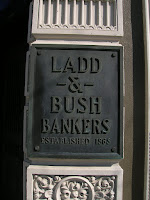 |
| Very early Ladd & Bush, showing the short 25-foot frontage on Commercial St. It looks like the frontage on State has already been expanded. The street trees are small. (WHC 1999.013.0024) |
 |
| A 70th anniversary pamphlet (via this great post on the cast iron and Ladd & Tilton bank at Cafe Unknown; also in the Hugh Morrow pamphlet collection at the Library) |
 |
| March 29th, 1919 |
From the piece:
During the early days of Salem, even for ten years after Oregon became a state, there was no bank in the city. Salem merchants sent their deposits to Portland or San Francisco in the Wells Fargo envelopes which were sold for five cents each, and payments for goods were all made in gold. There was no such thing as exchange.
It was early in 1869, while engaged in the mercantile business at the present location of the Hartman store, that Mr. John Albert was approached by Mr. Asahel Bush, with the suggestion that he become cashier of a new bank being built in Salem by Ladd & Bush.
 |
| Nameplate/cornerstone |
When Mr. Bush decided to open a bank in Salem, with Mr. Ladd he looked over the city for a location, and for a time was undecided whether to buy the corner property where is now located the Hartman jewelry store, or to buy the corner on Commercial and State streets. At that time there was some doubt as to which of these two corner would become the principal corner in the town. It was finally decided to buy the present location of the bank, and in the spring of 1868 the work of building began. The building was not completed until the spring of 1869. It extended 25 feet on Commercial Street with its present size on State Street.Appended to this is a "Reminiscence" by John Albert, but it's repetitive, a little flowery, and reads like something less reliable. (I may come back later to transcribe it in full.) One part of it on the Oregon Constitution and what must be a kind of Jacksonian anti-bank sentiment is interesting:
Population 4000 Then
Salem at that time had a population of about 4000 and all business was done with gold or silver, as greenbacks were worth only about 70 cents on the dollar. The question of the opening date was considered. Mr. Ladd objected when April first was suggested, saying it would never do to being on All Fools' day. Mr. Bush said, "Then open April second." Mr. Ladd replied that that was worse still, for it was hangman's day. Mr. Bush laughed at Mr. Ladd's superstition, but later approach Mr. Albert to see if they could not be ready on an earlier date. Mr. Albert suggested Monday, March 29th, and on that date the bank began business. The Rev. C. R. Bonnell, of the Episcopal church, was the first depositor. The night before he gave Mr. Alberts $50 to put to his credit when the bank opened.
Began with $50,000 Capital
The bank began with a capital of $50,000. The legal rate of interest was 12 per cent, and no higher rates was ever charged by the bank, although the curbstone brokers were getting as a high as 3 per cent a month.
For the first year Mr. Albert ran the bank alone; he was cashier, teller and bookkeeper. At this time he was twenty-six years old. Today the bank has thirty-two on its payroll. Mr. Albert remained with Ladd & Bush bank for sixteen years.
Of teh depositors of 1869, besides Mr. Albert, only nine are living. They are, Thos. Burrows, A. N. Gilbert, G. P. Litchfield, E. A. Thatcher and J. G. Wright, (Uzafovage & Wright), all of Salem, and A. B. Croasman and J. C. Thompson, now of Portland, George Holman, Salt Lake City, and Cyrus Yeaton, (Yeaton & Boon), now of Seattle.
No Formal Opening
There was no ceremony in opening the bank. The doors were opened march 29, 1869 at nine o'clock, and as was the custom in those days, were not closed until four o'clock. Salem merchants were not familiar with banking, and for a time preferred to make their payments in gold shipped to the wholesale houses by express. Finally they were educated to the fact that a bank exchange was just as reliable and a less expensive way of paying accounts. Newcomers who came from the east with greenbacks were surprise[d] to learn that paper was worth only 75 cents on the dollar on this coast, and that all business was done with gold and silver, and that greenbacks had to be converted into gold.
During Oregon's slow progress of admission, the great panic of 1857 destroyed confidence in banks everywhere and it was forcefully expressed in Article XI, Sec. I, of our constitution, videEven if the bank or its attitudes towards trees might make you cranky, it's worth considering the longevity!
"The legislative assembly shall not have the power to establish or incorporate any bank, or banking company, or moneyed institution whatever;..."
The price of gold in New York on the opening day of the bank was 131-1/2, equivalent to seventy-six cents for greenbacks. As it took two months by mail to New York and Return, the immigrant's greenbacks netted him about seventy cents, which he blamed on the banks - therefore he was not likely to become a depositor.


1 comment:
(Edit: Added nameplate image)
Post a Comment